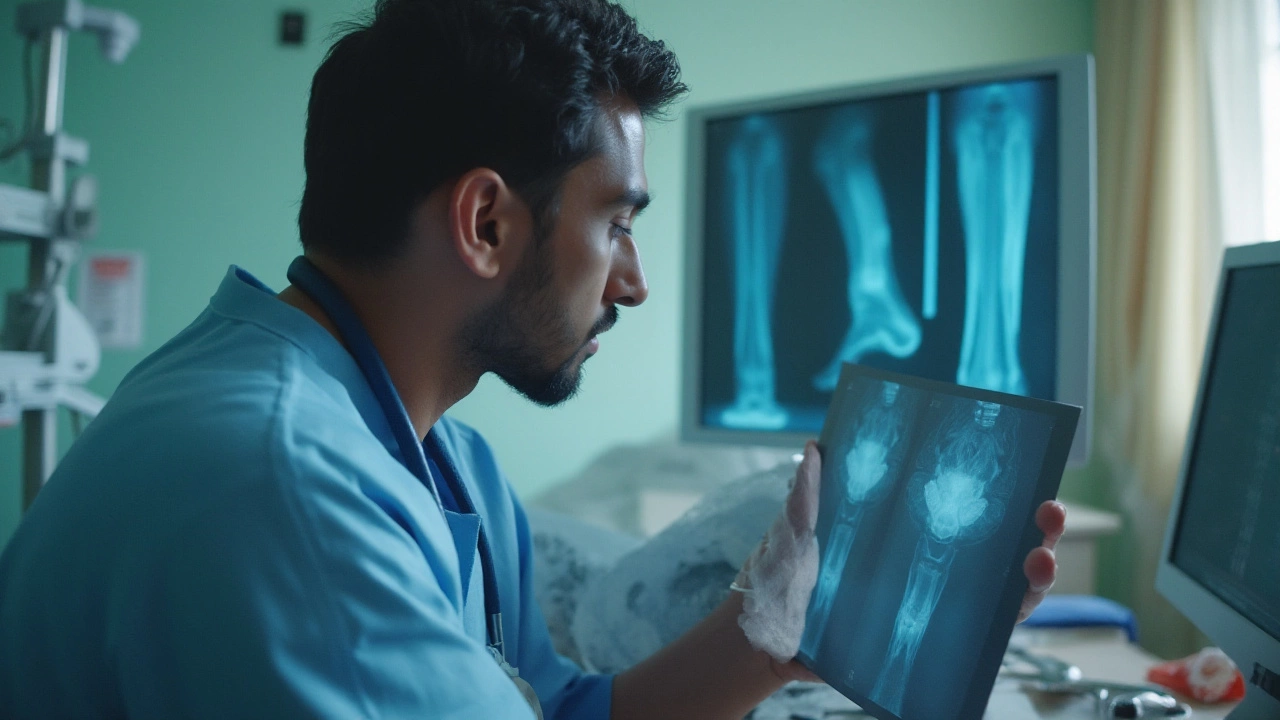Orthopedic emergencies are critical situations where immediate medical care is vital to prevent severe consequences. Among these emergencies, fractures stand out as the most common and often incapacitating injuries. When bones break, quick diagnosis and treatment become essential to avoid long-term damage and restore normal movement.
Fractures can occur from various causes, ranging from sports injuries to everyday falls. Recognizing the signs and knowing when to seek emergency help can make a significant difference in recovery outcomes. Not only does prompt medical attention help with physical recovery, but it also plays a crucial role in managing pain and preventing complications.
- Introduction to Orthopedic Emergencies
- What Are Fractures?
- Common Causes of Fractures
- Symptoms and Diagnosis
- Emergency Treatment Options
- Prevention and Recovery
Introduction to Orthopedic Emergencies
Orthopedic emergencies encompass a range of medical conditions that directly involve the musculoskeletal system requiring swift intervention. These situations often arise unexpectedly, prompted by incidents like falls, sports mishaps, or road accidents. The term "orthopedic emergency" primarily refers to conditions where bones, joints, or ligaments are compromised in ways that could bring about severe pain, disability, or even life-threatening complications without immediate care.
The urgency in addressing orthopedic emergencies stems from the critical role bones and joints play in our everyday function and mobility. When any part of this intricate system suffers damage, it doesn’t merely affect the immediate area but can also have ripple effects throughout the body, leading to impaired movement, systemic stress, and prolonged recovery periods, if not handled appropriately. Recognizing the gravity of these situations is indispensable, especially because timely diagnosis and treatment can mean the difference between a full recovery and long-term impairment.
One noteworthy consideration is that not all orthopedic injuries present themselves dramatically. Sometimes, what seems like a minor injury can escalate if not treated with the right urgency. For instance, a small fracture might initially feel like an insignificant pain, yet it can potentially lead to more serious complications if untreated. Understanding this distinction is vital, which is why education on these emergencies is an essential part of public health awareness.
"A fracture in time saves nine," goes an adapted old adage highlighting the importance of immediate action when one suspects a bone injury.
The most common orthopedic emergency, fractures, deserves particular attention in this regard. These incidents often require swift intervention to realign and stabilize the bone, reducing pain and preventing further injury. Hospitals with specialized orthopedic treatment facilities are well-equipped to make critical assessments and carry out necessary procedures effectively. It’s important to note that maintaining mobility and quality of life post-injury largely depends on the kind of emergency care one receives during the crucial early window following the injury.
This comprehensive understanding of orthopedic emergencies emphasizes why such ailments are treated with utmost seriousness in the medical community. Health practitioners and emergency responders undergo extensive training to ensure they can identify and treat these conditions rapidly and efficiently. Together with advancements in medical technology, timely and skilled medical intervention remains the backbone of effective emergency orthopedic care.
What Are Fractures?
Fractures occur when a bone, one of the body's essential support structures, cracks or breaks under stress. This type of orthopedic emergency is more than just a physical break; it's a serious disruption to the body’s skeletal framework. Understanding the nature of fractures is crucial in recognizing their impact and the necessity for immediate treatment. Fractures can affect any of the body's bones and vary in severity. They range from small hairline cracks to complete breaks that can pierce the skin, often referred to as compound fractures. Such injuries can be alarming not only for the physical pain they cause but also for the functional impairment they introduce, often necessitating a rapid medical response.
The classification of fractures is diverse, which is vital for diagnosis and treatment planning. There are stable fractures, where the broken ends of the bone line up and remain more or less in place, and displaced fractures, which involve bone fragments that are out of alignment. Compound or open fractures involve the bone puncturing through the skin, presenting a heightened risk of infection. Comminuted fractures involve the bone shattering into multiple pieces, typically due to high-energy trauma. This information is essential for first responders and medical practitioners as it influences treatment pathways and prognostic considerations.
The Mechanisms Behind Fractures
Fractures can occur through several mechanisms. A common cause is trauma, which might result from falls, car accidents, or sports injuries. Osteoporosis, a condition that weakens bones, makes them more susceptible to fractures even after minor falls or, at times, spontaneous injury without obvious trauma. Stress fractures, often seen in athletes, result from repetitive force or overuse—microtraumas accumulating over time until a bone fails. Understanding these mechanisms can guide preventive strategies and customize treatments to address underlying issues, such as strengthening bone density or mitigating repetitive strain.
"The desire to prevent fractures should be a priority, particularly for those in high-risk categories," notes Dr. Samantha Hill, a leading orthopedic surgeon. "Knowing your risk factors, like osteoporosis or high-impact sports, can significantly affect how one approaches daily activities."
Monitoring bone health is crucial, especially for older adults and those with existing conditions affecting bone density. It's worth noting how nutrition and lifestyle play crucial roles in maintaining bone strength. Calcium and vitamin D are critical for bone health, alongside weight-bearing exercises that promote bone density. By embracing these strategies, individuals can effectively reduce the risk of fractures, thereby avoiding this frequent orthopedic emergency.
Immediate Responses to Fractures
Once a fracture occurs, the body's response is immediate and aimed at protection and healing. Pain and swelling are natural responses as the body rushes blood to the injured area to start healing. Limiting movement is often the first instinct, which is why immobilization is one of the fundamental steps in initial fracture first aid. This is important to prevent further injury to surrounding tissues and aid in aligning the bones for eventual healing. Prompt and appropriate management of fractures can drastically affect recovery outcomes, highlighting the need for education on emergency response tactics for both individuals and healthcare teams.

Common Causes of Fractures
Fractures, often regarded as one of the most prevalent forms of orthopedic emergency, arise predominantly from a distinct set of causes, each with its own circumstances and mechanisms. The nature of a fracture – whether a bone simply cracks or shatters completely – can hinge significantly on the force, angle, and location of the impact. Understanding the myriad causes behind these bone injuries is crucial for prevention and informed response.
A primary culprit in bone injuries is high-impact trauma, often resulting from car accidents, falls from significant heights, or direct blows. These incidents can dramatically transfer energy to the body, causing bones to give way under sudden and extreme pressure. Sports enthusiasts and athletes frequently find themselves at risk here. In the realm of sports, activities like football, skiing, and wrestling present noticeable fracture risks. The combination of speed, physical contact, and sometimes unpredictable movements can easily culminate in intense moments where fractures occur.
Age plays a critical role in bone injuries, with osteoporosis being a significant contributing factor among older populations. This condition is notorious for weakening bones, making them more susceptible to breaks even under minimal stress or seemingly harmless circumstances. Elderly individuals might suffer fractures from something as simple as bending over or stepping awkwardly. Another important factor is repetitive stress or overuse, commonly seen in occupations demanding physical labor or in sports that require repetitive motions. Over time, even marginal stressors can lead to stress fractures, particularly in the legs and feet.
Health Conditions and Lifestyle Choices
Certain health conditions can predispose individuals to a higher risk of fractures. Issues such as bone cancer, cysts, or other bone-affecting diseases can significantly impair bone strength and integrity. Similarly, poor nutrition, especially diets deficient in calcium and vitamin D, can weaken bones over time, laying the groundwork for fractures.
Lifestyle choices also have a notable impact. Smoking and excessive alcohol consumption have been linked to lower bone density, increasing the chance of fractures significantly. Accidents involving heavy machinery or equipment without proper safety measures in place can also lead to unexpected fractures. Even environmental factors, like slippery sidewalks or uneven terrains, can contribute to causing falls resulting in bone injuries.
"Understanding the primary causes of fractures is key to prevention and ensuring timely treatment. Being informed is the first step toward keeping oneself safe." - Dr. X, Renowned Orthopedic Surgeon
| Cause | Percentage of Fractures |
|---|---|
| High-impact trauma | 45% |
| Osteoporosis | 30% |
| Sports injuries | 15% |
| Repetitive stress | 10% |
By recognizing these prevalent causes, individuals can take proactive measures, whether by altering daily habits, incorporating safety practices, or seeking regular health check-ups. An awareness of such factors empowers individuals to not only prevent fractures but also respond effectively if they do occur, ultimately enhancing recovery prospects.
Symptoms and Diagnosis
The symptoms of fractures vary depending on the type and location of the bone injury, but there are common signs to be aware of. A fractured bone is often accompanied by intense pain, which may increase with movement or pressure on the affected area. Swelling and bruising usually develop quickly, making it evident that the injury is more than just a simple sprain. Deformity might be noticeable, particularly in areas where the bone alignment has shifted. In cases of open fractures, where the bone punctures the skin, the signs are unmistakable, with bleeding and the visible end of the bone. It’s crucial to remember that immediate action is essential to minimize damage and improve recovery prospects.
For diagnosing orthopedic emergencies, medical professionals use a range of techniques. An initial physical examination allows them to assess the visible symptoms and determine the extent of the injury. X-rays are the most common diagnostic tool, providing a clear image of the bone structure and revealing any fractures or displacements. In some cases, a CT scan or MRI might be necessary to get a detailed image of the bone and surrounding tissues, which helps in identifying fractures not visible through regular X-rays or when complex injuries are suspected. Physicians rely on this comprehensive data to decide the best course of action for treatment.
A well-respected orthopedic reference states, "The accuracy of diagnosing complex fractures has increased markedly with the use of advanced imaging techniques such as computed tomography and magnetic resonance imaging, which allow for a thorough evaluation of the injury and any associated soft-tissue damage." This highlights the importance of not only recognizing visible signs but also utilizing technology to ensure a precise diagnosis.
In addition to imaging, medical history plays a role in the diagnostic process. Understanding the context of how the injury occurred can offer insights into potential complications and guide the treatment strategy. Information about the patient's health background, including any previous fractures or bone-related issues, also provides valuable clues. This holistic approach helps doctors tailor interventions to individual needs, aiming for the best possible recovery outcomes. Addressing bone injuries promptly and accurately is paramount in orthopedic emergencies, facilitating proper healing and reducing the risk of long-term impairments.

Emergency Treatment Options
When it comes to handling orthopedic emergencies, especially fractures, the timing and nature of the treatment are pivotal. The moment a fracture occurs, the focus shifts to stabilizing the injury to prevent further complications. Emergency departments are well-equipped with skilled professionals who are trained to provide immediate care. This involves a systematic process to assess the extent of injury, which starts with immobilizing the injured area to avoid any additional damage to the bone or surrounding tissues. By doing so, medical personnel can ensure the patient experiences the least amount of pain while minimizing the risk of the fracture worsening.
An X-ray is often the first diagnostic tool utilized to gain a visual confirmation of the fracture's location and severity. In more complex cases, CT scans or MRIs may be employed to provide a detailed view of the bone anatomy and surrounding soft tissue structures. This helps specialists to draft a precise treatment plan tailored to the nature of the fracture. The primary objective in emergency care is to realign the bone fragments as close to their natural position as possible, a process called reduction. Depending on the fracture, this may be done externally or might require surgical intervention.
For some fractures, non-surgical treatment involves the application of a cast or a splint to hold the bones in alignment during the healing process. In contrast, more severe fractures might necessitate surgical repair using metal rods, pins, or plates to stabilize the bones internally. Pain management also plays a crucial role in the patient's immediate care and recovery; thus, emergency rooms are stocked with analgesics and sedatives to alleviate discomfort and ease the distress of the patient.
"Emergency physicians need to be adept in quick decision-making and compassionate care to handle fractures effectively," says Dr. John Smith, an orthopedic specialist at the National Orthopaedic Hospital. "Timely intervention is key in ensuring a good prognosis for fracture patients."
The road to recovery doesn't end in the emergency room. Post-treatment, patients might require ongoing physical therapy to restore strength and mobility to the affected area. Regular follow-up appointments are crucial, as they allow orthopedic doctors to monitor the healing progress and make necessary adjustments to the treatment plan. It's a journey that requires patience and adherence to medical advice to prevent any future complications and to ensure a full recovery.
Prevention and Recovery
Preventing fractures is a vital focus for individuals of all ages, as bone injuries can significantly impact quality of life. Practicing safety measures such as wearing appropriate footwear and using protective gear while engaging in sports can reduce the risk of accidents. It’s crucial to maintain a healthy diet rich in calcium and vitamin D, as these nutrients are essential for bone strength. Regular weight-bearing exercises like walking or jogging increase bone density, reducing the risk of fractures. In the workplace, adhering to safety protocols and using ergonomic equipment also lowers the chance of incurring an orthopedic emergency.
Once a fracture occurs, recovery becomes an intricate and pivotal process aimed at restoring full mobility and function. The recovery timeline can vary depending on the type and location of the fracture, as well as the individual's health and age. After the initial emergency treatment, which may involve immobilization or surgery, follow-up care is critical. Physical therapy often plays a significant role in rehabilitation, helping individuals regain strength and flexibility. For instance, a study conducted by the American Academy of Orthopaedic Surgeons found that patients adhering to prescribed physical therapy regimens experienced a 30% faster return to normal activities. Embracing a positive mindset and closely following healthcare providers’ advice can substantially improve recovery outcomes.
"The first wealth is health," said Ralph Waldo Emerson, reminding us that taking preventive steps is always beneficial in the long run.
The path to full recovery requires patience and dedication, often involving changes in lifestyle and habits. Pain management strategies, whether through medication or alternative therapies such as acupuncture, can aid in reducing discomfort during recovery. It’s also essential to monitor progress with regular medical check-ups to ensure bones are healing correctly. For many, the support of family or community can provide motivation and emotional assistance throughout the recovery journey. In some cases, assistive devices such as crutches or braces might be necessary to facilitate movement and ensure safety.
Recovery Tips
- Stay hydrated and maintain a balanced diet to support bone healing.
- Participate in physiotherapy sessions as recommended.
- Avoid smoking and excessive alcohol consumption, as these can delay bone healing.
- Engage in low-impact exercises to gradually rebuild strength.
- Maintain a regular sleep schedule to aid recovery and overall health.
| Stage | Duration | Key Actions |
|---|---|---|
| Immobilization | 6-8 weeks | Wear casts or splints, limit movement of the affected area |
| Initial Healing | 8-12 weeks | Engage in gentle movement, begin physical therapy |
| Full Recovery | 12 weeks and beyond | Gradually return to normal activities, strength training |







